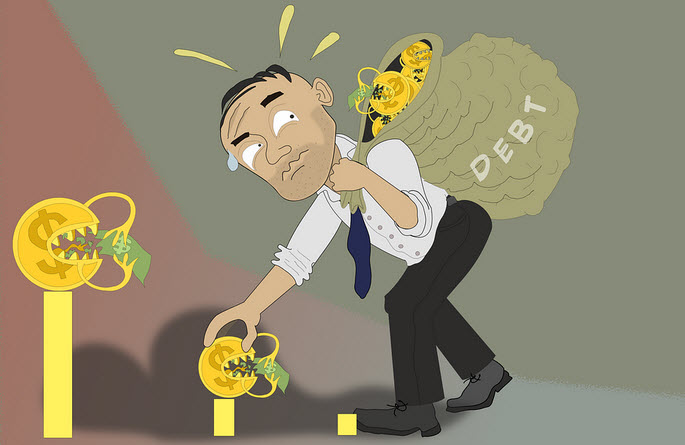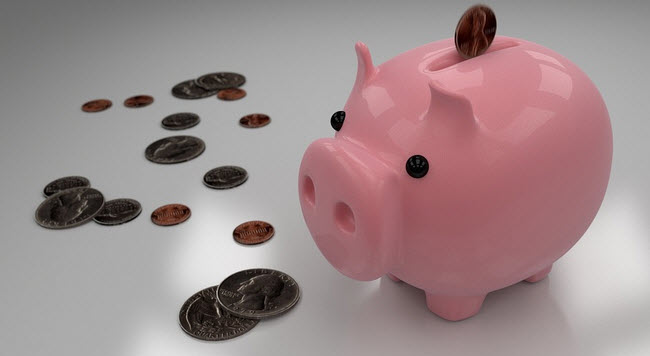
In the first step to save a million dollars, the theme was to research and pursue a suitable career with great earning potentials. For the second step, the central theme will be keeping more of our hard-earned money. In my minimizing your income tax post, I mentioned that “It’s not how much you make. It’s how much you get to keep.” This number is much more important and meaningful to us as savers than the gross amount of income that we make. By knowing approximately how much of our gross income that we get to keep, we can devise a suitable investment strategy to grow our savings and have that amount of money working harder for us. Eventually, our goal is to have our savings do all the hard work and we reap the benefit. Sounds good? Do I still have your attention? Great. Let the saving begin.

Student Loan Debt
In order for us to save money, we will have to have income, which means we need to be in the workforce. So the starting point for most people to save money is right after we complete our education and graduate with a degree of some sort (and hopefully it’s in the field that we are passionate about). From a recent National Post article, the average Canadian student graduated with a whopping $26,819 in student loans in 2015 (my student loan debt was $30,000 when I graduated back in 2003). That’s a deep hole to be digging ourselves out of when we’re just starting a new chapter of our lives. This is the first real obstacle that most of us will be facing early in our saving endeavour. To put that into perspective, let’s say that the interest rate on the student loan is 5%, it’ll take the borrow 15 years to pay off the student loan with a monthly payment of $211.37. For the few that graduated with minimal or no student loan debt, kudos to them for being in such a fortunate position. As for the rest of us, the student loan payment will be part of our lives for a while and a sizeable chunk of our income will be dedicated to paying it off. Regardless of the size of this debt, it’s considered to be a good form of debt as it’s an investment in oneself and the interest that we pay is tax deductible.

Consumer Debt
Based on a recent report from a credit monitoring agency, TransUnion, a typical Canadian owes about $21,686 of consumer debt (this number does not include mortgage debt) as of 2016. While this number is not staggering, it’s still a sizeable amount that can consume a good portion of one’s monthly income. For example, it will take the average person 10 years to pay off this loan with a monthly payment of $283.79 at a 5% interest rate. The total amount of interest paid for the 10 years duration is $7,235.03. Once again, this number is not significant by any means, but if one’s consumer debt keeps on growing and the average interest rate on the debt is more than 5%, the struggle to pay off debt will increase dramatically and the consequence will be a decreased in savings. In the same TransUnion report, the average balance on a credit card is $3,954, which equate to about $786.85 in interest payment per year for a common credit card with a 19.9% interest rate. Now the picture seems clear when credit card companies want to offer so many perks to cardholders to entice them to use their card for purchases. They want to make their 19.9% return.

Installment Loans
Before penning this post, I thought that my knowledge of debt and the different products out there in the market was pretty sound. Boy, was I dead wrong when I came across this article about payday and installment loans. I always thought that credit card and department store debt were the two worst culprits in the consumer debt category, but they are far from the worst. The two worst form of consumer debts is payday loans and installment loans. For example, some payday loan offer to lend $300 for a two weeks period and cost the borrow only $20. If we work out the borrowing rate, it cost about 173.33% (=26*[20/300]) on an annual basis. Unfortunately, most people who take out these loans think that it’s still pretty cheap that it only cost them $20 to borrow $300. For the installment loans, the annual interest rate ranges from 46% to just under 60%. The reason that it is just below the 60% mark is because it’s criminal to charge an interest rate of 60% or more for a loan. Criminal. The really sad part about these loans is the borrowers that could least afford these type of loans are the end users and are most likely to be low-income earners and financially stressed individuals.

Mortgage Debt
In 2015, the average size mortgage in all of Canada was approximately $193,778, based on research from LSM Insurance Canada Ltd. As of December 2016, the average house price was $470,661. Based on these two numbers (there is a one year difference, but it’s close enough for discussion purposes), most of Canadian are still carrying a sizeable mortgage debt. Let’s assume that the average amortization period left on the average Canadian’s mortgage is 15 years and the interest rate of 3% annually, that’s about $1,336.46 of a mortgage payment for the average Canadian. Still, this is not a huge monthly payment by any means, however, if we look at the total annual payment, the total about $16,037 in after-tax earnings.

Investment Debt
People incur investment debt when they take out a loan and use the total proceeds of the loan to either start a business, buy properties or invest in the financial market. Most experts tend to agree that this form of debt is good debt as they have potential to increase your wealth instead of draining it like consumer debt. This form of debt is not new, but in general, it’s easier for people to borrow to spend rather than to build wealth. As a result, this form of debt is seldom discussed and there are not a lot of statistics on this form of debt.

Average Canadian Salary
According to a salary article from Workopolis with data from Statistics Canada, the average Canadian makes just under $50,000 per year. With the personal tax calculator from TaxTips.ca, the lowest amount of income taxed paid per individual per year ranging from $7,725 (15.5% of $50,000) for individuals living in Nunavut to the highest of $11,036 (22.1% of $50,000) for Quebec residents assuming no deductions taken. Hence, the highest average monthly pay cheque is about $3,522 = [(50000-7725)/12] for Nunavut residents to the lowest of $3,247 = [(50000-11036)/12] for Quebec residents.

What About The Savings?
By now, you must be wondering about, “Where is the savings?” The only time that I mentioned the word savings was at the end of the first paragraph. So here it is:
Savings = [Income] – [Debt Payments] – [Living Expenses]
If we do the math for the average Canadian’s monthly savings, we have:
Savings = [$3,247 to $3,522] – [$1,336.46 + $283.79 + $211.37] – [Living Expenses]
Savings = [$1,415.38 to $1,690.38] – [Living Expenses]
If the average Canadian’s monthly living expenses such as food, utility bills, phone and internet bills, transportation and entertainment costs are between $1,415.38 to $1,690.38, then the average Canadian will have zero savings. If the living expenses are higher, then the average Canadian will be in a debt spiral. Even if the average Canadian’s living expenses come to about $1,200 a month, it’ll only leave the average Canadian about $215.38 to $490.38 in savings per month, which is about 5.17% and 11.77% of the average Canadian’s average income. That number does not factor in discretionary spending such as clothing, electronic gadgets, vacations, etc..
My Two Cents
So with all the statistics related to the average Canadian’s income, student, mortgage and consumer debts, what does it all mean? It means that when you have debt, the creditors have first dip in your income as you have to pay them first until you get rid of them. You need to be first in line to get paid before the creditors. That means you want to pay yourself first! To increase your savings, you’ll have to understand the different forms of debt and how it can cost you a fortune (bad debts) or help you make more money (good debts). So to keep more of your money in your pocket, you’ll have to keep the creditors out.
In The Third Step To Saving A Million Dollars, I will provide some insights on how to compound and grow your savings.


 About Leo
About Leo
I definitely agree that debt can help propel your wealth or can be a great deterrent to your wealth. It’s all about how comfortable you are using debt as a tool. If student loans enable you to become a doctor making tons of money. Definitely can be worth it. However, if you have credit card debt on stuff that you don’t have anymore. That can definitely be a waste of money.
As I always say MSM, there are good debts and there are bad debts. When debts cost me money, I tend to stay away from it. However, when I can use it as a tool to help me build wealth, bring it on. Three forms of debt that I think are acceptable as long as the interest rate is less than 5%, they are student loans, mortgage and investment debts.
I definitely agree with this sentence: “It’s not how much you make. It’s how much you get to keep.”
It always occur to me that how important it is I can get back after deduction of debts and CPF. Looking forward for your 3rd post.
The statement is very true Ivianat. When I look at my pay slip and see that before I even see a penny of my pay, the government is already taking more than 30% of my money, so I try my best to keep as much of whatever is left in my pocket. If you like savings, you’ll like the third post :).
Such a great and informative post! I always say that it’s not how much you make, it’s how much you save. Some people just aren’t responsible with their money and will never be secure no matter how much they make. So many great tips here! Thanks for sharing 🙂
You’ve hit the nail on the head Meagan. The key to growing your savings is to be disciplined and responsibled with your money. Spend wisely and save diligently.
Woah. I didn’t know that interest rates in Canada for loan installments are so high! Thanks for letting us know how it is there.
I was surprise to Alvin, when I read the article about the installment loans. Don’t even mention the double digit rates. When interest rates start to go above 5%, I am turning the other way when the lenders come asking for business. I prefer to earn those rates myself.
Great article. In general I am not a fan of debt money, as they are just too expensive and they take away the freedom of your life. Some debt of course are necessary and might help as student loans but the rest of debt money I believe should be avoided as much as possible.
Staying debt free is a great rule to live by Johana. I know quite a few fellow personal finance bloggers that are totally debt-free and it gave them quite a bit and freedom to do what they want. Not to mention, they sleep quite well at night without the debt burden.
great post!
Thank you for dropping by Bowie. I am glad that you enjoyed it.
Great tips! I would be great to have million now. But need to work towards it.
Work hard and save diligently Cindyrina, you’ll save that million one day. There is not quick way to earn a million bucks, but slow and steady will eventually get you there.
A very insightful article. I have always stressed that we should clear our credit card at the end of each cycle, so as not to allow interest to snowball. I don’t have debt at this point in life and I save my income after expenses. Therefore, I am most interested to read your follow-up article on how to grow our savings.
I totally agree that we should never carry a balance on our credit card, Emily. It seems like you’ve got a very good handle on debt as you are totally debt free. Debt is not that fun to talk about, but growing your saving is definitely fun, not to mention, it’s also very rewarding. I will definitely have fun talking about growing our savings in the next post.
Greatly written article. I do agree on the savings part especially- when the essentials have to be taken off from your total income (whether it be in the form of credit or not) to have a certain percentage being allocated to savings. Having creditors out is always a best thing too.
Shivani, when you allocate a certain percentage of your income to your savings, it’s called paying yourself first. This is what I use to motivate myself to save because I want to be the first one in line to access my money before anyone else. When you do it for a while, you’ll be surprised with the result that you’ll get and you’ll be more motivated to save.
What a good read. Now am happy to share that am debt free, and am just maintaining my one credit card for daily expensee.
Congrats for being debt free Blair. It’s definitely an achievement in itself. When you are debt free, you have more freedom to save and grow your wealth.
Absolutely right. will recommend this post to anyone who is eager to get out from rat race asap! thanks
Qian, you have definite seen through me. One of my motivations for working so hard to save my million is to get out of the rat race. The sooner I get there, the faster I’ll be out of the rat race and achieve freedom.
wow thanks for all the tips!!i need to save up more money for upcoming trip..
It’s never too early to save Cindy. The sooner you start, the more time your money will have to grow.
Always learning new & great tips on finance by reading your sharing here. Yeah! How much we are able to save from what we make really important! Cheers, SiennyLovesDrawing
Thank you for the complement SiennyLovesDrawing. Sharing my personal finance knowledge is what I love to do. Thank you for dropping by.
Thanks for the very informative and helpful post on how to save more. Definitely gonna need that extra help in saving these days.
I am glad that you find this useful. I sometimes feel that by reading other people blogs, it gives me a reminder to work harder to save when I read about how much other people can save. The attitude is, if they can do it, I think I can too. So you can definitely do it Rawlins.
Thanks for the sharing! Although I am not in a good saving journey but definitely a great help and tips for future saving purpose =D
Hi Sharon,
The key to saving for your future is to start early, save often and commit to building your own wealth.
Is hard to prevent from any debts. Our Money value has shrink but salary remain the same . Even owning a house or even a car is equivalent to 0 and the younger generation end up with debts. That why we need a proper planning for our own financial.
You are definitely on the right track Betty. This is the reason why I wrote the first step of saving a million dollars. If the younger generation spend some time to do the research and get in the right industry, they will be well prepared as they will be joining an industry with earning potential.
Another great post. I had employees who always went to the payday loan places to cash their cheque versus opening a bank account. It drove me crazy!! After a couple months they would eventually listen and open a account but it was mind boggling. Maybe they were getting paid to much =)
@PassiveCanadianIncome, it really saddens me to see people work so hard for their money, yet they just throw it away to payday loan companies. If they would have a little discipline and just wait a few days for the check to clear or to negotiate with their bank to release a portion of their pay cheque, they will save quite a bit of money. We can’t really help those people if they don’t help themselves.